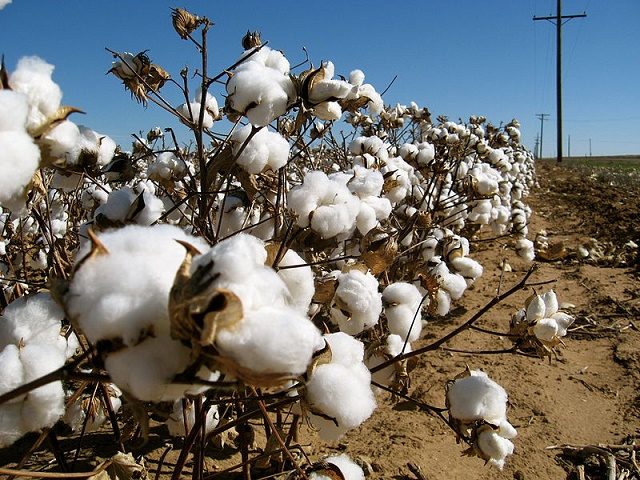A new relief program is set to distribute $300 million in “cost-share assistance payments” in the coming months as producers face the ginning season amid a global supply glut. Texas is expected to receive a substantial percentage of the funds due to its leading role in the market.
The U.S. Department of Agriculture’s (USDA) Cotton Ginning Cost Share (CGCS) program expects to provide one-time payments to qualifying producers “to expand and maintain the domestic marketing of cotton.” The USDA argues that the effort is needed to combat supply excess largely driven by China. The subsidy is intended to shore up those that are facing liquidation of land and farming equipment to satisfy debt obligations.
Qualifying producers can expect a payment worth 60 percent more than the one given in 2014 offering similar assistance. Payments will be calculated based on planted acres reported to the U.S. Farm Services Agency, multiplied by 40% of the average ginning cost for each production region in question. In Texas’ case, the payment rate will be $36.97 per acre. Applicants can expect a $40,000 payment limit and must be actively farming. Producers with a three-year average adjusted gross income of $900,000 or less may seek the funds.
“Today’s announcement shows USDA continues to stand with America’s cotton producers and our rural communities,” Secretary Tom Vilsack said in a statement.
West Texas Congressman Randy Neugebauer (R-Lubbock) generally lauded the program but argues that it does not go far enough.
“This is not producers’ first choice for how USDA could have addressed the downturn in cotton … The economic challenges facing cotton producers in our area are significant, and when farmers are in trouble, the whole community is affected,” the Texas-panhandle congressional representative said.
The retiring Lubbock representative wishes that the USDA designate cottonseed as an eligible oilseed – which would qualify producers for additional financial assistance under the Price Loss Coverage and the Agricultural Risk Coverage programs. In December 2015, 100 lawmakers signed a letter calling on Secretary Vilsack to switch the designation, arguing he could lawfully do so on his own under the 2014 Farm Bill. The USDA has resisted calls to reclassify cottonseed to date.
In February, House Committee on Agriculture leadership sounded the alarm on the dire threats facing the cotton industry at large. Chairman Michael Conaway (R-Midland) noted that the farm economy is currently experiencing the greatest three-year percentage in net income loss since the Great Depression – a roughly 56 percent contraction. American farmers continue to be muscled out of the global market by China.
China’s ‘Predatory’ Cotton Practices
For years, China has implemented a variety subsidy schemes to satisfy a number of national interests. Not only do subsidies placate any communist regime’s key constituency, farmers, from general revolt—but also soothes tensions that could otherwise boil over from the 600 million (majority Muslim) living in the northwestern Xinjiang region. Between direct purchases from producers to its strategic reserve; gap coverage between government benchmarks and market prices; and a 3:1 domestic-to-import quota, the Chinese farmers were supported to the tune of $5.1 billion dollars for the 2013-2014 seasons. American farmers, by contrast, saw $593 million, according to the Farm Press.
William Watson of the Cato Institute argued in January 2015 that foreign government interventions into the global cotton market are too often met with domestic subsidies to facilitate a rebalance. Barring a bilateral agreement between the U.S. and China, American farmers cannot expect real relief while Washington is outspent 8-to-1. The libertarian think tank argues that if Congress “wants to end distortions of global cotton prices”, they should “just stop voting for them.”
Chinese subsidies have shown a decrease in overall value in recent years. The regime paid $5.8 billion in the 2012-13 season compared to the most recent figure of $5.1 billion.
Texas continues to hold the title for most cotton production in the nation. The National Cotton Council reports the state harvested 4.5 million acres for the 2015-16 season, yielding 5.7 million bales — roughly 45 percent of the United States’ total yield. Both dry and irrigated farming methods can be seen throughout the South Plains and Panhandle regions.
Figures provided by the left-leaning Environmental Working Group show that Texas ranks second in overall farm subsidies received after Iowa. From 1995 to 2014, Texas received a rough total of $16.2 billion, compared to Iowa’s $16.9bn.
Logan Churchwell is a founding member of the Breitbart Texas team. You can follow him on Twitter @LCChurchwell.

COMMENTS
Please let us know if you're having issues with commenting.